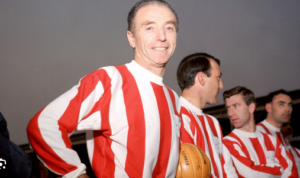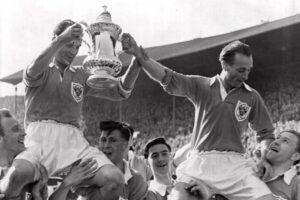The football world saw an incredible event on October 18, 1961, when 46-year-old icon Stanley Matthews made an incredible comeback to Stoke City. Stoke City, wThe football world saw an incredible event on October 18, 1961, when 46-year-old icon Stanley Matthews made an incredible comeback to Stoke City. Stoke City, who were having trouble in the Second Division, took the wise decision to pay a meagre £3,500 to get the legendary football player back. This move not only turned around their fortunes but also caught the attention of football fans all around the world.ho were having trouble in the Second Division, took the wise decision to pay a meagre £3,500 to get the legendary football player back. This move not only turned around their fortunes but also caught the attention of football fans all around the world.
The Resurrection of Stoke City
Stoke City was having a difficult season in the Second Division at the beginning of the 1960s. The team, beset by bad performance and declining support, was in dire need of a hero. Let’s introduce Stanley Matthews, a name that is linked to football greatness.
By the time Stanley Matthews returned to the club where it all started, he had already established a legendary career. Stanley Matthews was born on February 1st, 1915 in Hanley, Stoke-on-Trent. His career as a professional football player began in 1932, when he made his League debut while playing for Stoke City for the first time. He wore the red and white stripes.

The Wizard of the Dribble
Stanley Matthews was dubbed “The Wizard of the Dribble” because he was a living legend rather than just a football player. He was a real football wizard thanks to his incredible ball handling prowess and amazing wing runs. With remarkable quickness, agility, and a remarkable capacity to effortlessly fool opponents, Matthews was a captivating presence on the pitch.
Matthews first played for Stoke City from 1946 to 1947, when he moved to Blackpool. He rose to international prominence while he was with Blackpool, most notably for his legendary performance in the 1953 FA Cup Final, also known as the “Matthews Final.” Blackpool defeated Bolton Wanderers 4-3 in that unforgettable game after trailing 3-1, with Matthews orchestrating their stunning comeback.
Return to Stoke City
hen Stoke City was languishing in the English football league’s lower divisions in 1961, they took the audacious step of inviting their wayward son Stanley Matthews back home. Given his advanced age, re-signing Matthews was a risk, but it would turn out to be a brilliant move.
Stoke City’s fortunes took an unexpected turn with Matthews’ return. The Victoria Ground, which had just recently had low attendance levels, was now crowded with enthusiastic fans. Matthews’ reappearance had an instant impact; in the first game following his return, 35,974 fans showed out to see him, while only 8,409 attended the final home game before to his return.

In 1961, as Stoke City struggled in the lower echelons of English football, they made the bold decision to welcome back their prodigal son, Stanley Matthews. Re-signing Matthews was a gamble, given his advanced age, but it would prove to be a masterstroke.
With Matthews’ return, Stoke City’s fortunes took an astonishing turn. The Victoria Ground, previously witnessing meager attendance figures, now bustled with eager spectators. The impact of Matthews’ presence was immediate, as 35,974 fans flocked to witness his return in the first match after his arrival, compared to a mere 8,409 in the last home game before his return.
What happened next was quite remarkable. Stanley Matthews defied the rules of ageing with his amazing talents and fitness, even at 46 years old. His signature dribbling and accurate crosses continued to enchant opponents, encouraging a new generation of players and supporters alike.
It is important to remember that Stanley Matthews made history off the pitch as well as on it. He was the first recipient of the coveted Ballon d’Or, which is bestowed upon the finest football player in Europe, in 1956. His remarkable talent and services to the game were acknowledged with this distinction.
Matthews’ ageless excellence was not limited to Stoke City alone; he continued to play professional football until the age of 50, ultimately retiring in 1965. His remarkable career spanned over three decades, leaving an indelible mark on the sport.
The impact Stanley Matthews had on football went much beyond the pitch. He established a standard of commitment, professionalism, and sportsmanship that football players still follow today. He received multiple honours for his contributions to the game, including the illustrious Ballon d’Or and a knighthood.
Stanley Matthews’ return to Stoke City on this day in 1961 turned into a significant event in the history of football. It was more than just a return; it was evidence of the sport’s continuing allure and the ageless genius of one of its best players ever. Stanley Matthews demonstrated that a person’s love for the beautiful game could last a lifetime and that age was no longer a barrier to greatness. His memory endures as a source of motivation for football players and fans alike, reminding us that the wizardry of the ‘The Wizard of the Dribble’ will never fade away.
Leave a Reply